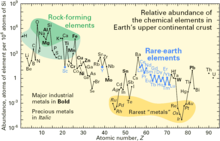
Back Relatiewe voorkoms Afrikaans Abundancia natural AN وفرة طبيعية Arabic Abondanza natural AST Rasprostranjenost u prirodi BS Abundància natural Catalan Přirozený výskyt Czech Naturlig forekomst Danish Natürliche Häufigkeit German Natura abundeco Esperanto

In physics, natural abundance (NA) refers to the abundance of isotopes of a chemical element as naturally found on a planet. The relative atomic mass (a weighted average, weighted by mole-fraction abundance figures) of these isotopes is the atomic weight listed for the element in the periodic table. The abundance of an isotope varies from planet to planet, and even from place to place on the Earth, but remains relatively constant in time (on a short-term scale).
As an example, uranium has three naturally occurring isotopes: 238U, 235U, and 234U. Their respective natural mole-fraction abundances are 99.2739–99.2752%, 0.7198–0.7202%, and 0.0050–0.0059%.[1] For example, if 100,000 uranium atoms were analyzed, one would expect to find approximately 99,274 238U atoms, approximately 720 235U atoms, and very few (most likely 5 or 6) 234U atoms. This is because 238U is much more stable than 235U or 234U, as the half-life of each isotope reveals: 4.468 × 109 years for 238U compared with 7.038 × 108 years for 235U and 245,500 years for 234U.
Exactly because the different uranium isotopes have different half-lives, when the Earth was younger, the isotopic composition of uranium was different. As an example, 1.7×109 years ago the NA of 235U was 3.1% compared with today's 0.7%, and that allowed a natural nuclear fission reactor to form, something that cannot happen today.
However, the natural abundance of a given isotope is also affected by the probability of its creation in nucleosynthesis (as in the case of samarium; radioactive 147Sm and 148Sm are much more abundant than stable 144Sm) and by production of a given isotope as a daughter of natural radioactive isotopes (as in the case of radiogenic isotopes of lead).
- ^ "Uranium Isotopes". GlobalSecurity.org. Retrieved 14 March 2012.